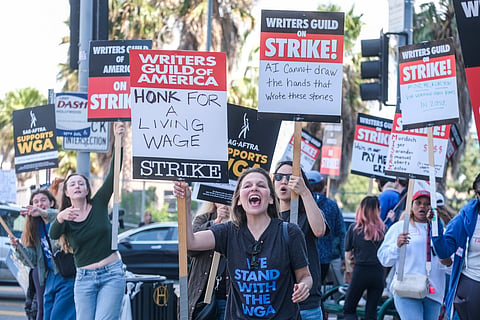OPINION | Connecting Washington Labor History and the Hollywood Strike
How Washington's history with labor movements gives Washingtonians a unique perspective on recent labor strikes.
by Christopher Lara
Hollywood officially ground to a halt when the Writers Guild of America (WGA) and the Screen Actors Guild and American Federation of Television and Radio Artists (SAG-AFTRA) began a strike after negotiations with the Alliance of Motion Picture and Television Producers (AMPTP) fell apart.
Originally, the strike only involved the WGA, which voted unanimously to strike after negotiations surrounding an increase in pay and better working conditions with AMPTP fell apart. The COVID-19 pandemic saw an increase in streaming service usage, which prompted the WGA to attempt to renegotiate its contracts.
For two months, the WGA led the strike alone, until July 14, when SAG-AFTRA joined the picket line after negotiations with AMPTP surrounding residual pay and the use of artificial intelligence fell apart.
This marks the first time since 1960 that both the WGA and SAG-AFTRA have gone on strike simultaneously. The Verge reported that in 2007, the WGA strike alone cost the California economy $2.1 billion in losses over the 100-day-long strike. With both the WGA and SAG-AFTRA engaged in the strike across the entire entertainment industry, the losses will surely be greater, especially if the strike continues for a long period of time.
Despite the strike being centered around the entertainment industry, Washington's history with labor unions and labor strikes gives Washingtonians an interesting perspective on strikes and their long-term effects.
Perhaps the most significant labor event in Washington was the 1919 Seattle General Strike. The strike saw 60,000 workers, including both shipyard union members and other unionized members, strike in an attempt to gather better pay and benefits. Because union members ran public services, the strike temporarily shut down Seattle, and City officials threatened to violently break down the strike.
The strike ultimately represented cross-industry worker solidarity in an attempt to gain better working conditions through peaceful collective action. Non-union members and families of union members also supported the strike in solidarity. The Seattle General Strike ended once many workers returned to their jobs, despite strikes continuing around Seattle's shipyards, but its legacy lived on in the later strikes that drew from its lessons.
During the 1919 strike, industrial workers managed to shut down a major city and major industries in an effort to gain negotiating power. And while they're not shutting down entire cities, the Hollywood strikers are preparing to shut down the entertainment industry, indefinitely suspending television programs, movies, plays, and many other forms of entertainment, in hopes of getting favorable negotiations.
In addition to the 1919 General Strike, Washington has also served as a hub for labor activism, with unions such as the Seattle Teachers Union, the International Longshoremen's Union, and Boeing Union representing major players in their respective industries.
With Starbucks being founded in Seattle, Washington has also been at the forefront of the movement for Starbucks stores to unionize. These unionization efforts, despite the immense pushback from Starbucks, saw members of younger generations taking leadership positions in the fight for the unionization of their stores.
South Seattle College professor Larry Cushnie says the rising cost of living and the post-COVID-19 labor boom have motivated young people to organize for their rights. "Millennials and Generation Z [are] potentially not doing as well as the generations before them financially within the workplace, [which] is causing people to look at what are the other options," Cushnie said. Cushnie says they're asking, "Where can I be able to protect myself and my work and the time that I am investing in and be compensated?"
This unique history with strikes and the labor movements gives Washingtonians an opportunity to reflect on the progress made by labor in our own state and explore how the Hollywood strikes can serve to benefit workers in the entertainment industry and beyond. The Seattle General Strike can serve as a larger model for the Hollywood strikes and future labor mobilizations, as workers coming together in solidarity — shown through the various unions coming together in 1919 and both the WGA and SAG-AFTRA mobilizing together today — is the key to ensuring equal protections for workers. And we've seen that workers can strike together in solidarity from across industries and in tandem with other unions to demand better conditions for all.
Christopher Lara (he/him) is a student at the University of Washington pursuing a degree in political science. Originally from San Jose, California, he enjoys organizing, baking, and reporting for The Daily of the University of Washington. His writing focuses on political developments and community. You can find him on Twitter@MrPresidentLara.
📸 Featured Image: Members of the Writers Guild of America (WGA) picket outside the Netflix, Inc., building on Sunset Boulevard in Los Angeles, California, on May 5, 2023. Photo via Ringo Chiu/Shutterstock.com.
Before you move on to the next story …
The South Seattle Emerald™ is brought to you by Rainmakers. Rainmakers give recurring gifts at any amount. With around 1,000 Rainmakers, the Emerald™ is truly community-driven local media. Help us keep BIPOC-led media free and accessible.
If just half of our readers signed up to give $6 a month, we wouldn't have to fundraise for the rest of the year. Small amounts make a difference.
We cannot do this work without you. Become a Rainmaker today!
Help keep BIPOC-led, community-powered journalism free — become a Rainmaker today.


